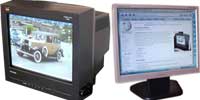Difference Between LCD and CRT
 LCD vs CRT
LCD vs CRT
Cathode Ray Tubes (CRT) were once the only way to convey pictures. They are large, bulky and consume a lot of power. Liquid Crystal Displays or more commonly known as LCDs are beginning to replace CRTs in most applications today. They are essentially the reverse of what CRTs are, light, thin, and energy efficient. Also, because of the high power consumption of CRT displays, it needs to dissipate a greater amount of energy which makes it run hotter compared to LCDs.
The only aspect where CRT wins over LCD in performance is in the response time. Older LCDs have been plagued with very slow response times that create ghosting effects on the screen whenever there is high speed motion. This made early LCD screens unsuitable for most gaming needs and even in viewing movies, but newer LCDs have improved on it and this is no longer such a big issue.
Understandably, LCDs cost significantly more compared to CRTs in displays of the same size due to the more complex production process that is needed to produce LCDs. But consumers often rationalize that the extra cost is recovered after a while due to the significantly lower power consumption. The physical dimensions of the LCD also meant that it is usable in so many applications where CRTs would simply be impractical to use. Aside from the usual TV screen or computer monitor, LCDs are also used in mobile phones, digital cameras, music players, GPS navigators, and so much more.
A problem that is unique to LCD screens is the dead pixel, which is unheard of in CRT screens. Since LCDs are a matrix of pixels, one or more of these pixels may not function due to irregularities in the production process. This leaves a small dot on the screen that doesn’t change with the display, appearing like a small piece of dirt stuck in there. Most manufacturers would accept and replace screens that have dead pixels in them but it is always best to inquire about the warranty and their dead pixel policy.
Summary:
1. CRTs are big and bulky while LCDs are thin and light
2. CRTs consume more power compared to LCDs
3. A byproduct of the power consumption, CRTs also get much hotter compared to LCDs
4. LCDs have a greater response time than CRTs
5. LCDs are considerably more expensive than CRTs
6. LCDs have more applications than CRTs
7. LCDs can suffer from dead pixels while CRTs do not
- Difference Between Sony Cybershot S Series and W Series - December 22, 2012
- Difference Between Samsung Galaxy S3 and iPhone 5 - December 21, 2012
- Difference Between Samsung Galaxy S2 (Galaxy S II) and Galaxy S 4G - December 20, 2012
Search DifferenceBetween.net :
6 Comments
Trackbacks
- Difference Between LCD and OLED | Difference Between | LCD vs OLED
- Difference Between LCD and HDTV | Difference Between | LCD vs HDTV
- Difference Between LCD and Flat Panel | Difference Between | LCD vs Flat Panel
- Difference Between DVI and Dual Link DVI | Difference Between | DVI vs Dual Link DVI
- Difference Between Plasma and Projection TVs | Difference Between | Plasma vs Projection TVs

this helps pc student technicians alot